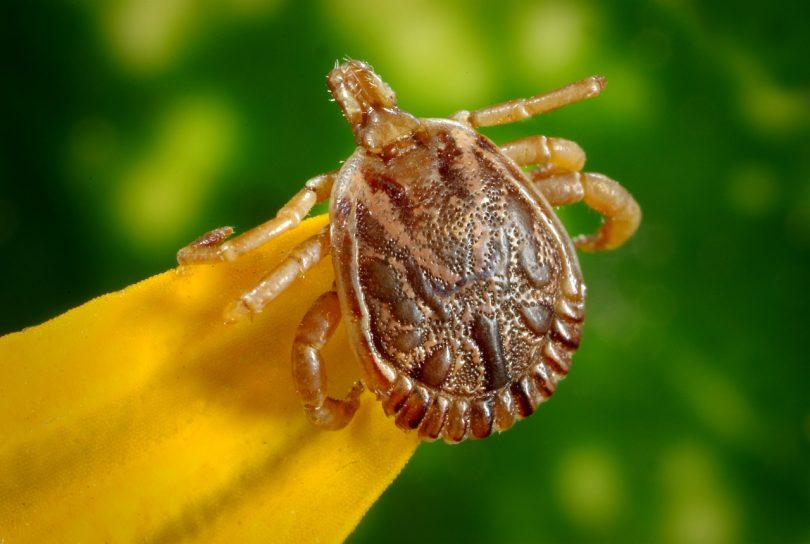A chigger is a parasitic mite that can latch onto your dog’s skin and cause serious irritation. Chiggers can cause severe itching, but the condition is treatable.
Read ahead to learn more about chigger infestations, how to treat the condition, and how to protect your dog from these mites:
What are Chiggers?
Chiggers are formally known as Trombiculid mites. As parasites, these minuscule insects attack dogs and people. Chiggers may be known by the following names too:
- Harvest mites
- Red Bugs
- Scrub mites
- Itch mites
- Rouget, and more
Chiggers, as annoying as they may be, have a long history on earth. Their existence may stretch back to prehistoric times. There are historical records of chigger infestations going back to the sixth century in China.
There are actually over 10,000 different types of chiggers out there. As alarming as it may sound, only a handful of these species harm dogs.
Chiggers are spread out on all populated continents. However, the mites are common in certain areas, such as forests or tall, grassy regions.
You should be worried about chiggers when you go on outdoor hikes or walks with your dog.
These mites love the warm weather. Therefore, be careful of chigger infections in the summer, or in regions with warm climates.
Chiggers are hard to spot because of their size. An adult chigger could be less than a millimeter in diameter. In the larval stage, a chigger is microscopic in size.
Chiggers cause problems in this larval stage. The mite larva survives by feeding on larger animals like dogs, birds, and people. The larva bites the skin, causing intense itching in the area.
How to Identify a Chigger Infestation
The most significant symptom of a chigger infection is unbearable itching. Your dog may constantly scratch or bite an area because of the mites.
Despite popular belief, chiggers don’t borrow inside the skin. Actually, the larva feeds on the exterior cells on the dog’s skin. The mites feed in an area for days secreting saliva that triggers an immune response, which causes the itching.
Here are some of the most conspicuous symptoms that indicate a chigger infection:
- Terrible itching that preoccupies the dog
- Itching that lasts for days
- Small, reddish welts on skin
- Scratches from itching
- Reddish patches where skin is exposed
Some dogs may not show obvious signs of chigger infections. The only sign would be itching that’s worse than usual.
Fortunately, chiggers don’t carry any diseases. However, the severe itching could lead to broken skin or scratches that get infected.
You can easily identify a chigger infection with a visual inspection. The mites may look like paprika on the fur if seen.
Chiggers can affect any skin area on a dog’s body. But the head, legs, and belly area are particularly vulnerable. Be aware that chiggers can infect a dog’s inner ears too.
Treating Chiggers on Dogs
Chigger infestations are not life-threatening but must be treated as soon as possible.
The dog will become very uncomfortable because of the itching. In addition, constant itching could put your dog at risk for secondary infections.
Chiggers don’t burrow under the skin, so these mites are relatively easy to get rid of. Here’s what you can do to remove chiggers off your dog:
- Wipe the mite-infected area with a warm, soapy cloth or a wipe designed for dogs.
- Give the dog a warm bath.
- Use a dog medication that kills mites and ticks. Treatments with acaricides are recommended.
- Use a systemic mite-killing treatment on your dog.
The itching will subside when the mites are gone. It may take up to a week for your dog to completely recover.
Proving Itch Relief
In some cases, you may need to treat the dog’s severe itching as well. It may cause skin inflammation. You can ask a veterinarian for a topical anti-inflammation cream like prednisone to reduce redness and the need to scratch.
What NOT to do:
Don’t try to use alternative treatments to relieve the itching. Some bloggers claim to use things like Epsom salt and green tea baths help with the itching. There’s no evidence to show that these treatments work.
A steroidal cream is the best option to reduce inflammation caused by itching. Ask a veterinarian for a prescription if you think it’s necessary.
Steps to Take to Prevent the Condition
There is not much dog owners can do to prevent chigger infestation because the mites can be anywhere outdoors. Keeping your dog indoors can prevent the dog from coming into contact with the mites.
Owners should be watchful when going outdoors in warmer climates or the summer. Mind those woodland areas where the mites may linger.
Should You Go to the Vet?
A chigger infestation isn’t a major illness. However, you may want to consult a veterinarian just in case to confirm the condition.
If your dog has welts or reddish patches of skin caused by itching, a trip to the vet is recommended. Your vet may prescribe a cream to treat the severe itching.






